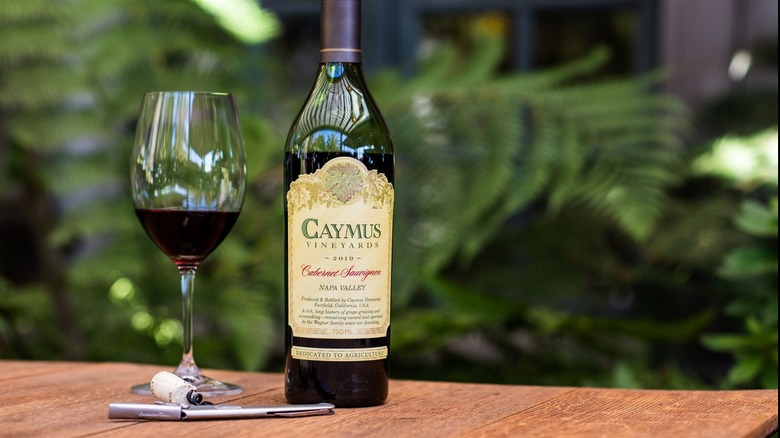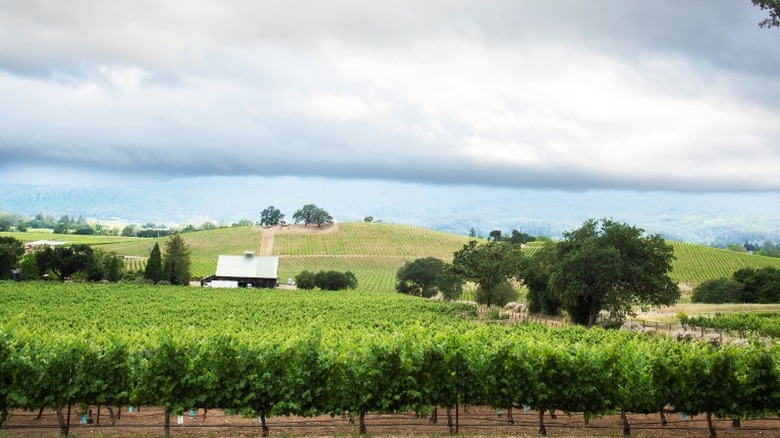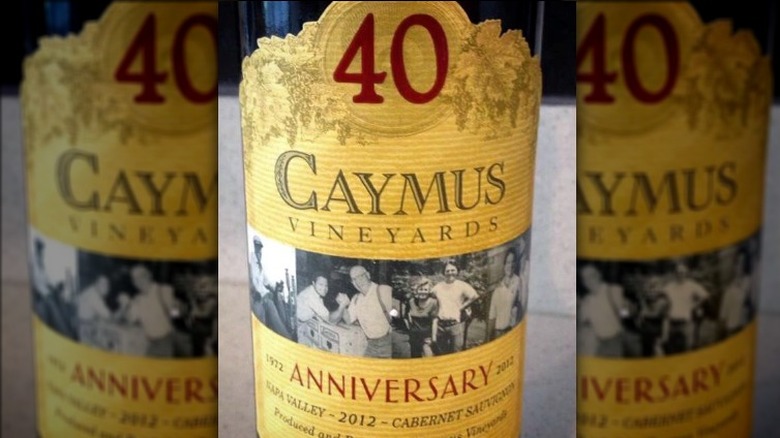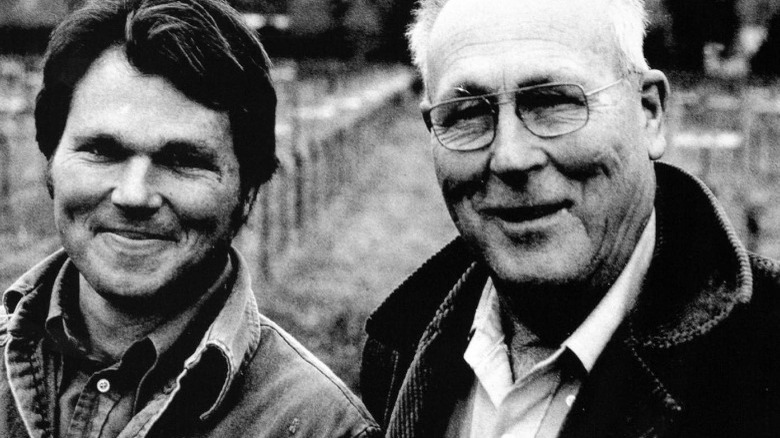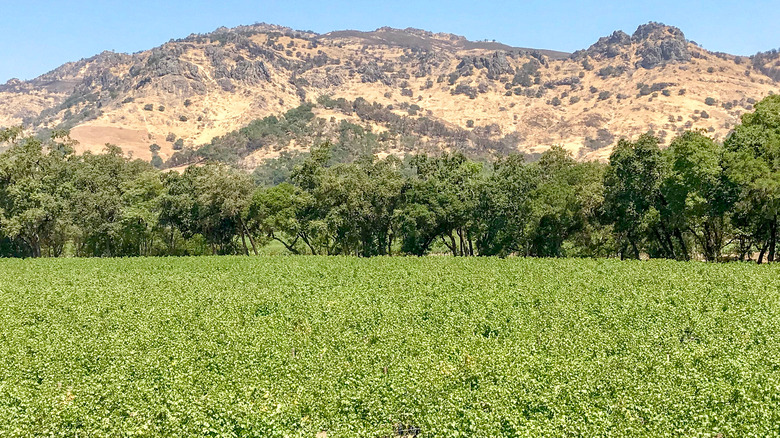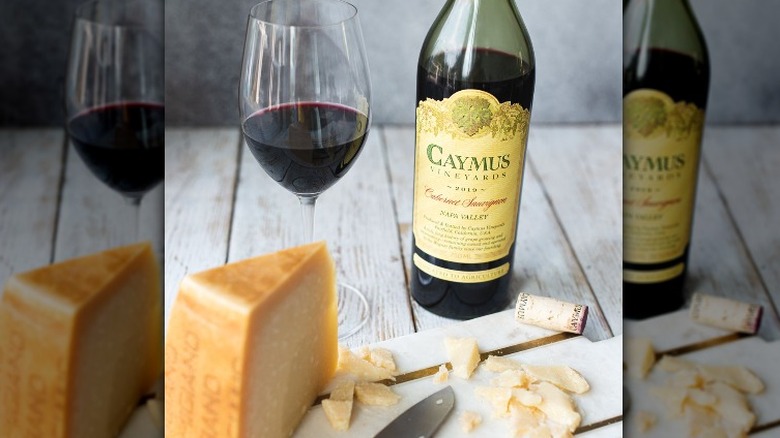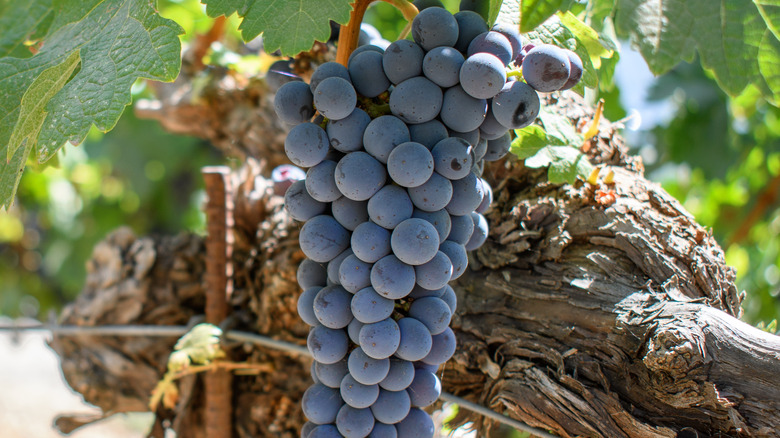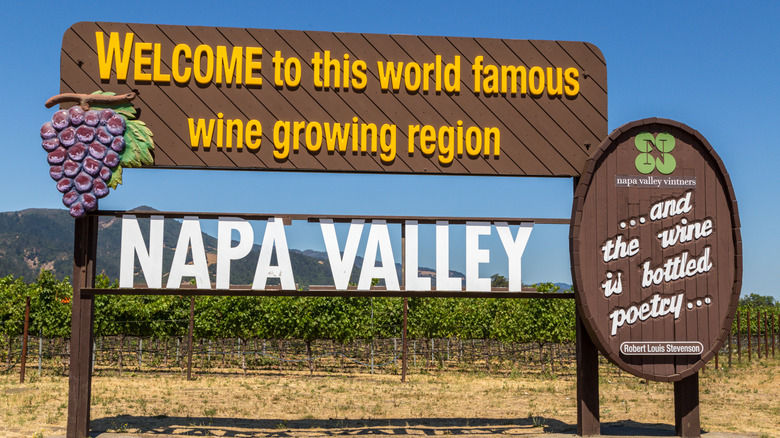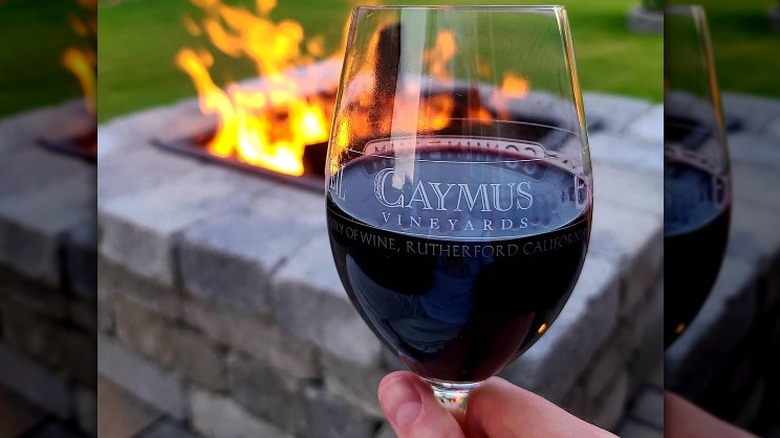Caymus Napa Valley Cabernet Sauvignon: The Ultimate Bottle Guide
Caymus Napa Valley Cabernet Sauvignon is one of the most beloved wines to come from the California region. One of Wine-Searcher's most sought-after bottles, Caymus is a wine you can score points when giving to your in-laws for Christmas or when brought as a hostess gift to your next dinner party.
Napa Valley and cabernet sauvignon are synonymous. Hundreds of thousands of thirsty visitors flock to the region every year to sip some of the world's finest wines. When the Wagner family began Caymus in the 1970s, there were just over a dozen wineries in Napa. Today, there are over 500 established wineries and over 1000 producers, per the Napa Valley Vintners. Still, each year, Caymus is a consumer favorite.
The winery's Instagram page shows everyone from celebrities and influencers to bachelorettes and sweethearts enjoying bottles of Caymus wine. In years past, Chicago Cubs pitcher Marcus Stroman, Houston Texan J.J. Watt, and future Hall-of-Fame tight end Rob Gronkowski have shared their enjoyment of bottles of Caymus Cabernet Sauvignon.
Wine critics also value Caymus. 50-year-old Caymus consistently receives 90+ scores. The winery's flagship product, Caymus Special Selection Cabernet Sauvignon, has been named "Wine of the Year" twice by Wine Spectator. It is the only wine to doubly receive this honor in the award's extensive history. Caymus Napa Valley Cabernet Sauvignon is more affordable while being equally delicious. But what is it about Caymus that the winery's top-selling selection popular among wine drinkers? You may be surprised to learn why.
Caymus has ties to the land
Celebrating its golden anniversary this year, Caymus is one of the oldest family-owned wineries in Napa Valley. Founded by a family with local farming roots that date back to the late 1800s, per Wine Spectator, Caymus began on a 73-acre plot purchased by the Wagner family in 1941 in the Rutherford District of Napa. In 1972, founders Charles F. "Charlie" Wagner, Sr., his wife, Lorna Belle Glos Wagner, and their 19-year-old son, Chuck, began Caymus Winery. The name was chosen after the Mexican land grant where the farm is located, which had originally been named Rancho Caymus after a Native American tribe that called the area home, notes The Napa Wine Project.
The family was ready for the task as the senior Wagner had been a home winemaker for years, coupled with knowledge acquired from several generations of farming Napa Valley land. Charlie, Sr. and Lorna, had been vintners for decades, selling the Wagner estate fruit to other wineries and watching it become beautiful wine for someone else. The most important aspect of making good wine was covered — quality fruit. Wagner's Rutherford-grown fruit is great. To this day, the Wagners lead with the belief that everything is tied to the land. First and foremost they are farmers at heart. Every bottle of wine proudly carries the mantra that Caymus is "dedicated to agriculture."
Caymus Cabernet Sauvignon was first sold at unbelievable prices
The same year the winery began, 1972, the Wagners produced the first vintage of Caymus Napa Valley Cabernet Sauvignon. The winery utilized grapes previously sold to Inglenook Winery, which under the leadership of a Napa icon, John Daniels, Jr., produced some of the finest Bordeaux-style wines in the world during the 1940s and 50s (via Guild Somm). Daniels sold the winery in 1964, and the next few years saw a change in Inglenook's direction regarding fine-wine production. It was the ideal time for Caymus to take the leading role in the Napa Valley story.
With the senior Wagner utilizing his skills as a home winemaker, and inspiration from helpful neighbors like legendary Napa Valley winemaker André Tchelistcheff of Beaulieu Vineyard, Caymus debuted its inaugural vintage. Just 250 cases of Caymus Cabernet Sauvignon were produced that year, with the wine selling for just $4.50 a bottle. The U.S. Inflation Calculator records that value as $31.47 today. What started as 250 cases in 1972 has grown to a production of 70,000 Caymus Napa Valley Cabernet Sauvignon cases annually, per WineBid.
A young Chuck Wagner joined the family business
Chuck Wagner began the winery with his parents when he was only 19. Barrons reports that the elder Wagners had invited their son to join them in starting a winery. Had he turned them down, the Wagner parents would move to Australia to begin a new adventure. Instead, Chuck agreed, and today he says one of the greatest gifts of his life was being able to work alongside his parents in the winery for 30 years.
By the time Chuck Wagner joined his parents as the lone employee of Caymus, he was almost a veteran farmer. At age 14, Wagner Jr. took over the family's 73-acre farm after his father was shot eight times by an angry former employee, per Barrons. Until then, he had helped his father work the land, assisting with picking fruit and pruning vines, so he wasn't taking on the responsibility blindly. Still, Wagner Jr. hadn't yet been the one making the decisions.
Lucky for us, as he began working the vines, his youthful eyes noticed that the grape leaves looked unhealthy. Powdery mildew, which Vine Forecast defines as a season-ending disease with the potential to destroy an entire vintage, had crept into the Caymus vineyard. Wagner Jr. turned to a neighbor who helped him eliminate the fungus and save the fruit. After this, he knew he had found his calling. Thankfully, his father recovered, and they began the family-owned winery five years later. Today, it remains a Wagner-run business.
Caymus has ties to another award winning wine
The Grape Collective notes that when the Wagner's purchased their Rutherford estate, prunes and walnuts were the main crops. However, Napa Valley was quickly transforming from fruit and nut trees to vineyards, with cabernet sauvignon emerging as the leading variety in the region. Vintner Nathan Fay was the first to plant cabernet sauvignon grapes in the Stag's Leap District of Napa Valley, putting 90 acres under vine in 1961 (via Wine Spectator). Fay sold his fruit to Napa's winemakers, quickly gaining a reputation as some of the finest in the region. As fate would have it, Fay and Wagner Sr. were friends. In the late 1960s, when the Wagners began adding wine grapes to their Rancho Caymus estate, Fay gave them cuttings from his vines to propagate the vineyard.
Years later, Fay Vineyard Stag's Leap District Cabernet Sauvignon would win the prestigious 1976 Judgment of Paris, as reported by Time Magazine. The wine tasting competition pitted Napa Valley chardonnay and cabernet sauvignon against the finest Bordeaux and Burgundy wines of the time. The tasting competition was judged by some of the most prominent French winemakers, and these critics determined the outcome. The result was shocking and ground-breaking for the emerging wine region, planting Napa Valley squarely on the international wine map.
Maria Carey's favorite wine
According to Maria Carey, the best way to get over a bad breakup is with a good wine, Caymus in particular. Billboard Magazine's 2019 top female artist of the year shared her love of Caymus just a year before her award, tweeting that the Caymus 2014 Cabernet was one of her favorite bottles of wine. When she debuted her song "GTFO" in 2018, the artist included the lyrics, "Might as well down this Caymus bottle." Per Variety, the shout-out sent winery sales soaring as Carey's fans began acquiring bottles. Though Caymus had hosted the artist at the winery some years before, they had no idea until the song debuted that Carey had such a love for the wine.
Such is the beauty of wine; when you've tasted the extraordinary, it sticks with you. In a Forbes op-ed from The New York Times best-selling author Larry Olmstead, Olmstead shares that Caymus Cabernet Sauvignon is his favorite bottle of wine as well. His words are impressive, as the travel, food, and wine journalist has visited dozens of countries and tasted the best of the best. According to Olmstead, the texture and body of Caymus Cabernet Sauvignon are "transformative."
The taste of Caymus is unparalleled
Wine-Searcher offers that the style of Caymus is "unapologetically New World," which means that the wines are big and showy, very ripe, and juicy. These characteristics occur through various vineyard techniques that enhance the wine's supple qualities. Caymus practices crop thinning, removing excess bunches of grapes from the vine before they ripen, which helps the remaining fruit become intensely concentrated. Additionally, the vineyard allows its grapes to ripen for an extended period on the vine before harvest, otherwise known as an increased hang time. The fruit becomes very luscious and sweet, further concentrating the flavors.
These techniques ensure consistency in the wine vintage after vintage. Once produced, the wine has aromas of blackberry and cherry, milk chocolate, cocoa powder, roasted espresso, and licorice. These aromas lead to plush flavors of ripe black cherry, blackberry jam, dried currant, vanilla marshmallow, and chocolate fudge, with warm spices, like nutmeg and clove that mingle with toasted oak. The wine balances sweet and savory, which is exactly what we've come to expect from Caymus.
Balance is important to the winery, notes Grape Collective. Wine can be of high alcohol, but if acidity, tannic structure, and fruit ripeness balance, the wine is complete. The alcohol percentage of 2019 Caymus Napa Valley Cabernet Sauvignon is 14.6% ABV, similar to other vintages of the wine.
Caymus Cabernet comes from a range of terrains
Initially, every bottle of Caymus Napa Valley Cabernet Sauvignon once came from fruit grown on the Rutherford estate (via Wine Cellar Insider). Today, Charlie Wagner, Jr. shares that the winery opts to focus on a diversity of locations in each vintage, honoring the Caymus history while bringing in innovation. By employing Napa's diverse microclimates, Caymus can bring qualities to its wine that Rutherford terroir does not present. These characteristics include different flavors and aromas and derive from a mix of soils, elevations, and sun exposures not found in Rutherford.
According to the Wagner family, today's wine blends fruit from eight American Viticultural Areas within the valley. 25% of the fruit comes from mountain vineyards, like Atlas Peak and Howell Mountain, and 75% is valley-floor fruit from cool, southern Coombsville on to the warmest AVA in Napa, Calistoga. In Napa's mountain vineyards, grapes struggle to find nutrients. Here, vines dig deep into the mineral-rich earth of volcanic mountains, bringing tannic structure and density to the fruit. Conversely, the nutrient-rich valley floor brings forth the supple qualities of the fruit, per Napa Valley Vintners. The characteristics of different soils become infused into the fruit, and utilizing various terrains brings diversity to the Caymus Cabernet Sauvignon.
After harvest and fermentation, the wine is aged in oak barrels, but details on how long this occurs (and the type of barrels used) are not easily shared. Still, upon the first sips of the Caymus Cabernet Sauvignon, we clearly tasted the influence of oak on the wine. Yet, Caymus is notoriously tight with reporting this sort of information, and so we'll have to wonder.
How to serve and pair Caymus
Worldwide, caves and cellars are often used for aging wine. The dark, cool, slightly humid cellar allows aging to occur slowly, allowing tannins to ease (via Vin Folio). At home, store your bottle on its side in the coolest, darkest place possible, like the bottom of a dark closet or on a rack in the basement, where the wine won't be jostled or moved. Generally, it is safe to store your wine in any place under 65 degrees Fahrenheit. Heat, light, and vibration create the largest threat to wine, each potentially destroying the juice inside, shares Wine Spectator.
Caymus is best enjoyed at around 60 degrees Fahrenheit, per Wine Cellar Insider. The wine shouldn't be warm, as heat can taint the wine, but serving too cold will hide the wine's bouquet. If drinking a youthful vintage, decant the red wine for an hour before drinking. If you don't have a decanter, simply open the bottle, pour a glass, and swirl once poured, allowing the wine to aerate or breathe. Allowing the wine to come into contact with air will help the initial bite of alcohol dissipate, the aromas will open, and the tannins will soften.
Caymus is fruit-forward enough not to require food for enjoyment. When paired with food, however, steakhouse favorites are an easy compliment. We suggest juicy ribeye steaks, a classic burger, pork chops bone-in, or pairings like this lamb chop recipe. America's top restaurants keep Caymus Cabernet on their lists because it is very approachable. Because of this, the winery sits comfortably among an annual shortlist of producers that are most popular in America's fine dining establishments, such as Fleming's and Ruth's Chris (Wine & Spirits Magazine).
Why buy Caymus Cabernet Sauvignon?
With so many Napa Valley Cabernet Sauvignon options available, what should you look for when buying Caymus versus another brand? We look at the price, style, soil, and story considering any bottle of wine. With Caymus, the style becomes the top consideration. Caymus is the style of cabernet sauvignon that put Napa on the map, with vintage after vintage delivering consistent quality (via Forbes). Caymus has a silky, soft texture and round consistency you can always feel in the wine. The finish is velvety and smooth on the palate, rounding out the fruit-forward style. The tannins are soft, and acidity is subdued, both desired qualities for enjoying wine with or without food. However, to experience both with such a young wine leads us to believe the wine may not be a contender to age for many years.
Like Caymus, Lail Vineyards has a rich, lengthy history within the Napa Valley. Co-founded by a daughter of the region, Robin Lail. Lail's father was John Daniels, Jr., the producer of Inglenook wines, where the Wagner's had been selling their grapes before the creation of Caymus. Priced comparably, Lail's Blueprint Cabernet Sauvignon similarly blends fruit from a variety of Napa regions, including mountain and valley floor, and is aged for some time in oak (via Wine-Searcher). However, Lail's offering brings complexity that must be searched for in Caymus. The wine reveals an Old World, European style from New World fruit, delivering texture, structure, depth, and elegant refinement. Lail's Blueprint displays delicate restraint, producing a wine ready for enjoyment today and one that will age nicely.
Caymus is expensive, but worth it
Ten years ago, Forbes noted that a bottle of Caymus cost around $60. Today the current vintage sells for $82 (via Wagner Family of Wines). This is a significant increase considering the only thing about the wine that has changed is that inflation continues to rise. Alongside gasoline, housing, bread, milk, and meat, high-end wine prices continue to go up (via the U.S. Bureau of Labor Statistics). Still, consumers are willing to pay.
Top sommeliers have shared with Wine & Spirits that Caymus Cabernet Sauvignon has brand loyalty, noting customers must have Caymus on the wine list. Similarly, restauranteurs note that customers often decide they will order a Caymus bottle before even seeing a wine list (via Wine & Spirits). The wine is usually under $200 at a restaurant, making it a nice "date night" splurge that customers can count on. Those who order it know that Caymus Cabernet is consistently going to be juicy, fruit-forward, food-friendly, and delicious. Interested tasters can find the wine at wine shops and liquor stores across the country, ranging from $70-$120, depending on the retailer you shop, with a complete list available via Wine-Searcher.
